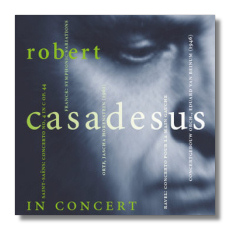
The Internet's Premier Classical Music Source
Related Links
- Latest Reviews
- More Reviews
-
By Composer
-
Collections
DVD & Blu-ray
Books
Concert Reviews
Articles/Interviews
Software
Audio
Search Amazon
Recommended Links
Site News
 CD Review
CD Review
Robert Casadesus

In Concert
- Camille Saint-Saëns: Piano Concerto #4 in C minor, Op. 44
- César Franck: Symphonic Variations
- Maurice Ravel: Concerto for the Left Hand *
Robert Casadesus, piano
ORTF Orchestra/Jascha Horenstein
* Concertgebouw Orchestra/Eduard van Beinum
Music & Arts CD-1133 AAD monaural 54:45
Casadesus recorded all of these concertos in the studio, even in stereo. These are live monaural recordings in less than perfect sound. The Saint-Saëns and Franck date from September 26, 1961 at the Montreux Festival, and the Ravel from October 23 or 24, 1946. One might ask why this release was necessary, given what is already available on CD. The answer is two-fold. First, Casadesus and Horenstein never worked together on a studio recording. Second, hearing Casadesus live creates a frisson not generally available from his studio recordings, fine as they are.
Given a choice between a note-perfect performance with no particular atmosphere and an imperfect performance with special excitement or insight, I'll always take the latter. Modern conservatories teach young musicians to be athletes, not poets or magicians. Hearing Casadesus, one is reminded that there is more to getting to the bottom of a work than just playing the right notes at the right time. Remember, also, that studio recordings are not "real"; they usually are put together like a quilt from the best takes. These performances, while technically secure, betray the occasional missed note or lack of synchrony between the pianist and the orchestra. Does it matter? No, when the musicianship is as heady as this. Perhaps because he was a Frenchman, Casadesus was a master at combining precision and passion. He played intellectually, and with the faintest hint of a wry smile in the music, as if he were mocking himself. Even so, he could sweep the listener off his feet with the excitement of his pianism. This is not always apparent on his studio recordings, but it is impossible to miss here. Horenstein apparently was in a warm mood at the Montreux Festival in 1961; he keeps things flowing and gets excellent work out of the French orchesta. (In fact, this is one of the most intense readings of the Franck I've encountered.) Compared to Ormandy, with whom Casadesus recorded the Ravel Left-hand concerto in 1947 and 1960, Van Beinum is sober, and more willing to bring out the score's dark colors.
I have no complaints about the sound on this CD. The Montreux material, albeit monaural, is just a hair shy of what was possible in recording studios at that time. Even though it is fifteen years older, the Ravel from Amsterdam sounds remarkably good too. Distortion, pitch fluctuation, and clarity are not problematic at all on this historical release; there's a little hiss in the Ravel, but the ear compensates. Praise also to annotator Donald Manildi, although I wish he had included more information about the circumstances behind these live performances in his booklet note.
Copyright © 2004, Raymond Tuttle


















